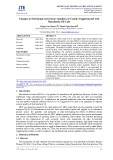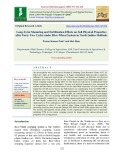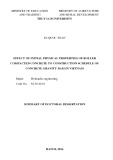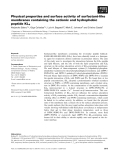
TNU Journal of Science and Technology
230(01): 48 - 55
http://jst.tnu.edu.vn 48 Email: jst@tnu.edu.vn
THE EFFECTS OF PACKAGING MATERIALS ON BREADFRUIT FLOUR’S
PHYSICAL AND MICROBIAL PROPERTIES DURING STORAGE
Tran Thi Minh Thu1*, Dang Thi Cam Tuyen1, Tran Thi Ngoc Tam1, Tran Thi Thuy Linh1,
Nguyen Ngoc Trang Thuy1, Tran Nguyen Phuong Lan2
1Can Tho University of Technology, 2Can Tho University
ARTICLE INFO
ABSTRACT
Received:
25/6/2024
This study examined the physical and microbial properties of the
breadfruit flour over a 16-week storage period at 25°C. Four
packaging materials, including high- and low- density polyethylene
(HDPE and LDPE), polyamide (PA), and polyamide/aluminum (PA-
Al), were used. The flours moisture content, brightness, yellowness
levels (L* and b* values, CIELab), water adsorption capacity (WAC),
swelling power (SP), pH, total plate count (CFU/g) of aerobic bacteria
and fungi were assessed every 3 weeks. Results indicated that flour
stored in PA-Al bags showed the least moisture increase (7.32% to
8.31%), followed by PA, HDPE, and LDPE (up to 9.03%). PA-Al
packaging also effectively maintained brightness (reduced by 1.1%),
yellowness (increased by 5.5%), pH (increased by 1.5%), WAC and
SP (increased 12% and 34%, respectively), making the flour
preferable for food storage. Initial aerobic bacterial counts were under
102 CFU/g, rising to 2.1 x 103 CFU/g, while fungal counts increased
at least from 0 to 17 x 102 CFU/g in PA-Al bags compared to PA,
HDPE, and LDPE. These findings demonstrated that PA-Al
packaging is most effective in preserving its attributes over time.
Revised:
16/10/2024
Published:
17/10/2024
KEYWORDS
Breadfruit flour
Microbial
physical properties
Packaging
Storage
NGHIÊN CỨU ẢNH HƯỞNG CỦA LOẠI BAO BÌ BẢO QUẢN ĐẾN
TÍNH CHẤT VẬT LÝ VÀ VI SINH CỦA BỘT SA KÊ
Trần Thị Minh Thư1*, Đặng Thị Cẩm Tuyên1, Trần Thị Ngọc Tâm1, Trần Thị Thùy Linh1,
Nguyễn Ngọc Trang Thùy1, Trần Nguyễn Phương Lan2
1Trường Đại học Kỹ thuật Công nghệ Cần Thơ, 2Trường Đại học Cần Thơ
THÔNG TIN BÀI BÁO
TÓM TẮT
Ngày nhận bài:
25/6/2024
Nghiên cứu này đã khảo sát tính chất vật lý và vi sinh của bột sa kê
trong thời gian bảo quản 16 tuần ở 25°C. Bốn loại vật liệu bao bì
gồm polyethylene mật độ cao và thấp (HDPE và LDPE), polyamide
(PA) và polyamide/nhôm (PA-Al) được sử dụng. Độ ẩm, độ trắng, độ
vàng (giá trị L* và b*, hệ màu CIELab), khả năng hấp phụ nước
(WAC), độ trương nở (SP), độ pH, tổng số vi khuẩn hiếu khí và nấm
men (CFU/g) được đánh giá 3 tuần một lần. Kết quả cho thấy bột
được bảo quản trong túi PA-Al có độ ẩm tăng ít nhất (7,32% đến
8,31%), tiếp theo là PA, HDPE và LDPE (lên đến 9,03%). Bao bì
PA-Al duy trì hiệu quả độ sáng (giảm 1,1%), độ vàng (tăng 5,5%),
pH (tăng 1,5%), WAC và SP (tăng 12% và 34%). Số lượng vi khuẩn
hiếu khí tăng thấp nhất từ dưới 102 CFU/g lên 2,1 x 103 CFU/g trong
khi nấm tăng từ 0 đến 17 x 102 CFU/g khi bảo quản trong túi PA-Al
so với các túi PA, HDPE và LDPE. Kết quả này cho thấy bao bì PA-
Al có hiệu quả nhất trong việc bảo quản loại bột này.
Ngày hoàn thiện:
16/10/2024
Ngày đăng:
17/10/2024
TỪ KHÓA
Bột sa kê
Vi sinh
Tính chất vật lý
Bao bì
Bảo quản
DOI: https://doi.org/10.34238/tnu-jst.10660
* Corresponding author. Email: ttmthu@ctuet.edu.vn


















